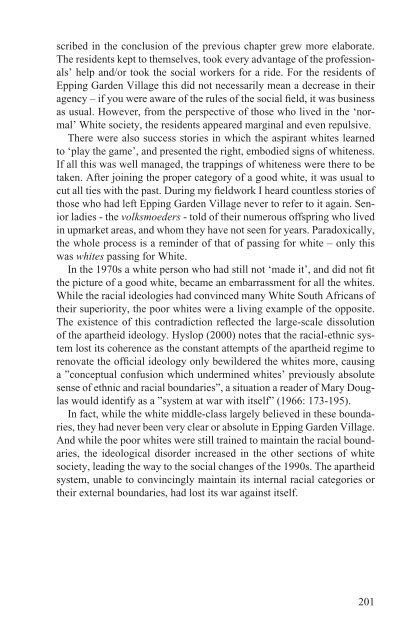The Making of a Good White - E-thesis - Helsinki.fi
The Making of a Good White - E-thesis - Helsinki.fi
The Making of a Good White - E-thesis - Helsinki.fi
Create successful ePaper yourself
Turn your PDF publications into a flip-book with our unique Google optimized e-Paper software.
scribed in the conclusion <strong>of</strong> the previous chapter grew more elaborate.<br />
<strong>The</strong> residents kept to themselves, took every advantage <strong>of</strong> the pr<strong>of</strong>essionals’<br />
help and/or took the social workers for a ride. For the residents <strong>of</strong><br />
Epping Garden Village this did not necessarily mean a decrease in their<br />
agency – if you were aware <strong>of</strong> the rules <strong>of</strong> the social <strong>fi</strong>eld, it was business<br />
as usual. However, from the perspective <strong>of</strong> those who lived in the ‘normal’<br />
<strong>White</strong> society, the residents appeared marginal and even repulsive.<br />
<strong>The</strong>re were also success stories in which the aspirant whites learned<br />
to ‘play the game’, and presented the right, embodied signs <strong>of</strong> whiteness.<br />
If all this was well managed, the trappings <strong>of</strong> whiteness were there to be<br />
taken. After joining the proper category <strong>of</strong> a good white, it was usual to<br />
cut all ties with the past. During my <strong>fi</strong>eldwork I heard countless stories <strong>of</strong><br />
those who had left Epping Garden Village never to refer to it again. Senior<br />
ladies - the volksmoeders - told <strong>of</strong> their numerous <strong>of</strong>fspring who lived<br />
in upmarket areas, and whom they have not seen for years. Paradoxically,<br />
the whole process is a reminder <strong>of</strong> that <strong>of</strong> passing for white – only this<br />
was whites passing for <strong>White</strong>.<br />
In the 1970s a white person who had still not ‘made it’, and did not <strong>fi</strong>t<br />
the picture <strong>of</strong> a good white, became an embarrassment for all the whites.<br />
While the racial ideologies had convinced many <strong>White</strong> South Africans <strong>of</strong><br />
their superiority, the poor whites were a living example <strong>of</strong> the opposite.<br />
<strong>The</strong> existence <strong>of</strong> this contradiction reflected the large-scale dissolution<br />
<strong>of</strong> the apartheid ideology. Hyslop (2000) notes that the racial-ethnic system<br />
lost its coherence as the constant attempts <strong>of</strong> the apartheid regime to<br />
renovate the <strong>of</strong><strong>fi</strong>cial ideology only bewildered the whites more, causing<br />
a ”conceptual confusion which undermined whites’ previously absolute<br />
sense <strong>of</strong> ethnic and racial boundaries”, a situation a reader <strong>of</strong> Mary Douglas<br />
would identify as a ”system at war with itself” (1966: 173-195).<br />
In fact, while the white middle-class largely believed in these boundaries,<br />
they had never been very clear or absolute in Epping Garden Village.<br />
And while the poor whites were still trained to maintain the racial boundaries,<br />
the ideological disorder increased in the other sections <strong>of</strong> white<br />
society, leading the way to the social changes <strong>of</strong> the 1990s. <strong>The</strong> apartheid<br />
system, unable to convincingly maintain its internal racial categories or<br />
their external boundaries, had lost its war against itself.<br />
201
















